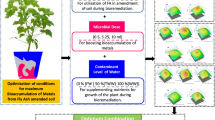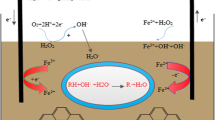Abstract
Phytoremediation using the tropical plant Melastoma malabathricum L. has been investigated as an alternative to conventional treatment methods for the remediation of lead (Pb) contamination in soil. In the present study, lead (Pb) bioaccumulation by M. malabathricum L. was evaluated and optimized using response surface methodology (RSM). The Box–Behnken design (BBD) was used to maximize the removal of lead (Pb), with three major variables employed (Pb concentration in sand: 20–70 mg/kg; exposure time: 14–70 days; aeration rate: 0–3 mL/min) in the optimization. The predicted optimum conditions were 44.1 mg Pb/kg for the lead (Pb) concentration in sand, an exposure time of 14 day and 0 L/min aeration rate, with an actual lead (Pb) bioaccumulation of 3596.0 mg Pb/kg. This value compares well to the value predicted by RSM (3855.1 mg Pb/kg). The difference between the validation value and the predicted value was within 6.7%, indicating that RSM was able to predict the optimum lead (Pb) bioaccumulation precisely with very low error. The maximum lead (Pb) bioaccumulation can be attained without requirement of aeration, resulting in a cost-effective treatment system.




Similar content being viewed by others
References
Al-Baldawi IAW, Abdullah SRS, Hasan HA, Suja F, Anuar N, Mushrifah I (2014) Optimized conditions for phytoremediation of diesel by Scirpus grossus in horizontal subsurface flow constructed wetlands (HSFCWs) using response surface methodology. J Environ Manage 140:152–159
Al-Sbani NH, Abdullah SRS, Idris M, Hasan HA, Jehawi OH (2016) Sub-surface flow system for PAHs removal in water using Lepironia articulate under greenhouse conditions. Ecol Eng 87:1–8
Bashir MJ, Aziz HA, Yusoff MS, Adlan MN (2010) Application of response surface methodology (RSM) for optimization of ammoniacal nitrogen removal from semi-aerobic landfill leachate using ion exchange resin. Desalination 254:154–161
bin Halmi MIE, Abdullah SRS, Wasoh H, Johari WLW, bin Mohd Ali MS, Shaharuddin NA, Shukor MY (2016) Optimization and maximization of hexavalent molybdenum reduction to Mo-blue by Serratia sp. strain MIE2 using response surface methodology. Rend Fis Acc 27:697–709
Bingöl D, Hercan M, Elevli S, Kılıç E (2012) Comparison of the results of response surface methodology and artificial neural network for the biosorption of lead using black cumin. Biores Technol 112:111–115
Box GE, Wilson K (1951) On the experimental attainment of optimum conditions. J Royal Stat Soc Ser B 13:1–45
Cao S et al (2015) Levels and source apportionment of children’s lead exposure: could urinary lead be used to identify the levels and sources of children’s lead pollution? Environ Pollut 199:18–25
Cho Y, Bolick JA, Butcher DJ (2009) Phytoremediation of lead with green onions (Allium fistulosum) and uptake of arsenic compounds by moonlight ferns (Pteris cretica cv Mayii). Microchem J 91:6–8
Guagliardi I, Cicchella D, De Rosa R, Buttafuoco G (2015) Assessment of lead pollution in topsoils of a southern Italy area: analysis of urban and peri-urban environment. J Environ Sci 33:179–187
Gunawan ER, Basri M, Rahman MBA, Salleh AB, Rahman RNZA (2005) Study on response surface methodology (RSM) of lipase-catalyzed synthesis of palm-based wax ester. Enzyme Microbial Technol 37:739–744
Halmi MIE, Jirangon H, Johari W, Abdul Rachman A, Shukor M, Syed M (2014) Comparison of microtox and xenoassay light as a near real time river monitoring assay for heavy metals. Sci World J 2014:834202-1–834202-10. https://doi.org/10.1155/2014/834202
Hasan HA, Abdullah SRS, Kamarudin SK, Kofli NT (2011) Response surface methodology for optimization of simultaneous COD, NH4+–N and Mn2+ removal from drinking water by biological aerated filter. Desalination 275:50–61
Hu Z-H, Yu H-Q, Zheng J-C (2006) Application of response surface methodology for optimization of acidogenesis of cattail by rumen cultures. Biores Technol 97:2103–2109
Idris M, Abdullah S, Rozaimah S, Titah HS, Latif MT, Ayub R (2014) Degradation of total petroleum hydrocarbon in phytoremediation using terrestrial plants. Environ Asia 7(2):36–44
Idris M et al (2016) Screening and identification of plants at petroleum contaminated site in Malaysia for use in phytoremediation. J Environ Sci Manag 19
Ismail NI et al (2017) Accumulation of Fe-Al by Scirpus grossus grown in synthetic bauxite mining wastewater and identification of resistant rhizobacteria. Environ Eng Sci 34:367–375
Karamba KI et al (2016) Optimisation of biodegradation conditions for cyanide removal by Serratia marcescens strain AQ07 using one-factor-at-a-time technique and response surface methodology. Rend Fis Acc 27:533–545
Khan AG (2005) Role of soil microbes in the rhizospheres of plants growing on trace metal contaminated soils in phytoremediation. J Trace Elem Med Biol 18:355–364
Larouci M, Safa M, Meddah B, Aoues A, Sonnet P (2015) Response surface modeling of acid activation of raw diatomite using in sunflower oil bleaching by: Box-Behnken experimental design. J Food Sci Technol 52:1677–1683
Maran JP, Manikandan S, Thirugnanasambandham K, Nivetha CV, Dinesh R (2013) Box-Behnken design based statistical modeling for ultrasound-assisted extraction of corn silk polysaccharide. Carbohydr Polym 92:604–611
Moreira GA, Micheloud GA, Beccaria AJ, Goicoechea HC (2007) Optimization of the Bacillus thuringiensis var. kurstaki HD-1 δ-endotoxins production by using experimental mixture design and artificial neural networks. Biochem Eng J 35:48–55
Nafady NA, Bagy MMK, Abd-Alla MH, Morsy FM (2015) Mahmoud GA-E Improvement of medium components for high riboflavin production by Aspergillus terreus using response surface methodology. Rend Fis Acc 26:335–344
Purwanti IF, Abdullah SRS, Idris M, Basri H, Hamzah A, Mukhlisin M, Latif MT (2014) Artificial aeration for the enhancement of total petroleum hydrocarbon (TPH) degradation in phytoremediation of diesel-contaminated sand. In: Aris A, Tengku Ismail T, Harun R, Abdullah A, Ishak M (eds) From sources to solution. Springer, Singapore, pp 301–306
Selamat SN, Abdullah SRS, Idris M (2014) Phytoremediation of lead (Pb) and Arsenic (As) by Melastoma malabathricum L. from contaminated soil in separate exposure. Int J Phytorem 16:694–703
Shukor Y, Baharom NA, Rahman FA, Abdullah MP, Shamaan NA, Syed MA (2006) Development of a heavy metals enzymatic-based assay using papain. Anal Chim Acta 566:283–289
Shukor M, Rahman M, Suhaili Z, Shamaan N, Syed M (2009) Bacterial reduction of hexavalent molybdenum to molybdenum blue. World J Microbiol Biotechnol 25:1225–1234
Singh KP, Gupta S, Singh AK, Sinha S (2011) Optimizing adsorption of crystal violet dye from water by magnetic nanocomposite using response surface modeling approach. J Hazard Mater 186:1462–1473
Sultan K, Shazili NA, Peiffer S (2011) Distribution of Pb, As, Cd, Sn and Hg in soil, sediment and surface water of the tropical river watershed, Terengganu (Malaysia). J Hydro Environ Res 5:169–176
Tangahu BV, Sheikh Abdullah SR, Basri H, Idris M, Anuar N, Mukhlisin M (2011) A review on heavy metals (As, Pb, and Hg) uptake by plants through phytoremediation. Int J Chem Eng 2011:939161-1–939161-31. https://doi.org/10.1155/2011/939161
Tangahu BV, Abdullah SRS, Basri H, Idris M, Anuar N, Mukhlisin M (2013) Phytoremediation of wastewater containing lead (Pb) in pilot reed bed using Scirpus grossus. Int J Phytorem 15:663–676
Titah HS, Abdullah SRS, Mushrifah I, Anuar N, Basri H, Mukhlisin M (2013) Effect of applying rhizobacteria and fertilizer on the growth of Ludwigia octovalvis for arsenic uptake and accumulation in phytoremediation. Ecol Eng 58:303–313
Titah HS, Abdullah SRS, Mushrifah I, Anuar N, Basri H, Mukhlisin M (2014a) Optimization of arsenic phytoremediation by Ludwigia octovalvis in pilot reed bed system using response surface methodology. In: Aris A, Tengku Ismail T, Harun R, Abdullah A, Ishak M (eds) From sources to solution. Springer, Singapore, pp 251–255
Titah HS, Abdullah SRS, Mushrifah I, Anuar N, Basri H, Mukhlisin M (2014b) Phytotoxicity and uptake of arsenic by Ludwigia octovalvis in a pilot reed bed system. Environ Eng Sci 31:71–79
Udechukwu BE, Ismail A, Zulkifli SZ, Omar H (2015) Distribution, mobility, and pollution assessment of Cd, Cu, Ni, Pb, Zn, and Fe in intertidal surface sediments of Sg. Puloh mangrove estuary. Malaysia Environ Sci Pollut Res 22:4242–4255
Watanabe T, Osaki M, Yoshihara T, Tadano T (1998) Distribution and chemical speciation of aluminum in the Al accumulator plant, Melastoma malabathricum L. Plant Soil 201:165–173
Witek-Krowiak A, Chojnacka K, Podstawczyk D, Dawiec A, Pokomeda K (2014) Application of response surface methodology and artificial neural network methods in modelling and optimization of biosorption process. Biores Technol 160:150–160
Zalewska M (2012) Response of perennial ryegrass (Lolium perenne L.) to soil contamination with zinc. J Elementol 17:329–343. https://doi.org/10.5601/jelem.2012.17.2.14
Acknowledgements
This research was financially supported by the Malaysian Ministry of Education and Universiti Kebangsaan Malaysia under FRGS-1-2013-TK07-UKM-02-7 and DIP-2014-020 grants.
Author information
Authors and Affiliations
Corresponding authors
Ethics declarations
Conflict of interest
The authors declare that there is no conflict of interest regarding the publication of this paper.
Rights and permissions
About this article
Cite this article
Selamat, S.N., Halmi, M.I.E.B., Abdullah, S.R.S. et al. Optimization of lead (Pb) bioaccumulation in Melastoma malabathricum L. by response surface methodology (RSM). Rend. Fis. Acc. Lincei 29, 43–51 (2018). https://doi.org/10.1007/s12210-017-0656-5
Received:
Accepted:
Published:
Issue Date:
DOI: https://doi.org/10.1007/s12210-017-0656-5




